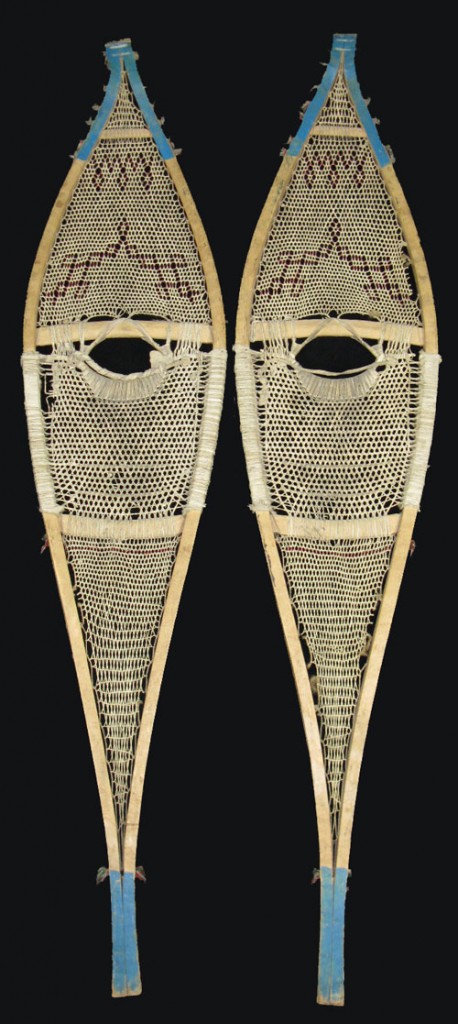Decorated Native Snow Shoes
Although antique Native snow shoes make appealing wall art on a purely aesthetic basis, they also embody history and cultural identity, a combination intrinsic to all good antique Native American art. Since tribes across the northern expanse of North America made and used different styles of snow shoes, there exists a wide variety of shapes, sizes, materials and forms of decoration.
Having handled pairs of snow shoes from many areas, we are usually able to readily identify their region of origin. When in doubt, we consult the few references that anthropologists have written specifically about traditional snow shoes, and read collection histories on pairs of snow shoes in museum collections.
This pair (above) from inventory is an excellent example of Eastern Cree snow shoes.
A photo (below) in the publication “Central Cree and Ojibway Crafts # 8 – Transportation” (Indian and Northern Affairs, Ottawa, Canada, 1974) shows a pair having the identical shape and similar decoration that was made by an Eastern Cree tribe member in Eastmain, Quebec, a township on the eastern shore of James Bay that is about an 18-hour drive northwest of Montreal. Those snow shoes, which are in the National Museum of Man in Ottawa, were made for a child seven to ten years of age, so are only 36” long x 8.5” wide.
In contrast, the snow shoes we have are a whopping 58” high x 13” wide so would have been made for an adult, but still are quite a bit larger than average adult snow shoes that we’ve seen from other regions.
They date from circa 1900-1920, and their condition is very good with a few areas where the webbing has broken away from the frame.
They have a two-piece construction, with the birch frame halves sewn together at the front end and held together with metal fasteners at the back end. The toes are pointed and steam bent in an upturned fashion, and the babiche webbing is moose or caribou hide.
At the central foot section which bears the most pressure, the birch is covered in cotton canvas beneath the strands of webbing that are strapped around the frame to prevent abrasion of the babiche.
In addition to assessing age, authenticity and condition of antique snow shoes, we look for special decorative touches that elevate their artistic merit. The most striking decoration on these snow shoes is the pattern created within the weave where the weaver pulled the warp in various ways to create geometric designs. The pulled warp pattern is accented with red paint.
Other decoration includes blue paint highlighting the tips and ends of the frame, and multi-color wool tassels applied along the edges of the tip and tail.
Although these snow shoes were made for everyday use, they are beautiful as well as practical. They manage to simultaneously convey ruggedness and artistic delicacy, far and away outshining the manufactured wooden snow shoes that turn up at flea markets in abundance. We wear apple red and powder blue aluminum snow shoes to trek around on for winter recreation, but antique decorated Native American snow shoes such as these now bring visual rather than functional rewards.























